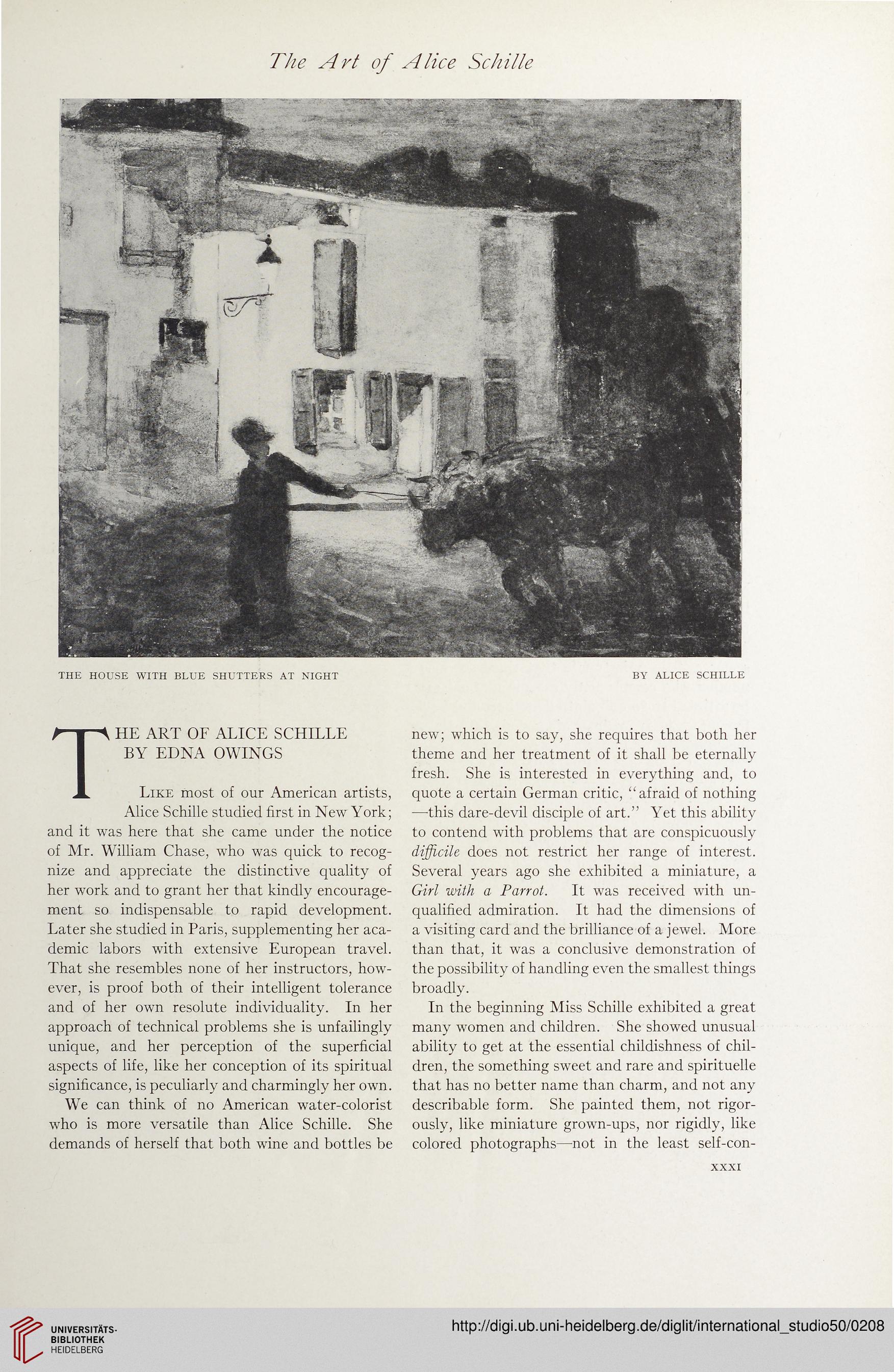The Art of Alice Sc hi lie
THE HOUSE WITH BLUE SHUTTERS AT NIGHT BY ALICE SCHILLE
HE ART OF ALICE SCHILLE
BY EDNA OWINGS
Like most of our American artists,
Alice Schille studied first in New York;
and it was here that she came under the notice
of Mr. William Chase, who was quick to recog-
nize and appreciate the distinctive quality of
her work and to grant her that kindly encourage-
ment so indispensable to rapid development.
Later she studied in Paris, supplementing her aca-
demic labors with extensive European travel.
That she resembles none of her instructors, how-
ever, is proof both of their intelligent tolerance
and of her own resolute individuality. In her
approach of technical problems she is unfailingly
unique, and her perception of the superficial
aspects of life, like her conception of its spiritual
significance, is peculiarly and charmingly her own.
We can think of no American water-colorist
who is more versatile than Alice Schille. She
demands of herself that both wine and bottles be
new; which is to say, she requires that both her
theme and her treatment of it shall be eternally
fresh. She is interested in everything and, to
quote a certain German critic, “afraid of nothing
—this dare-devil disciple of art.” Yet this ability
to contend with problems that are conspicuously
difficile does not restrict her range of interest.
Several years ago she exhibited a miniature, a
Girl with a Parrot. It was received with un-
qualified admiration. It had the dimensions of
a visiting card and the brilliance of a jewel. More
than that, it was a conclusive demonstration of
the possibility of handling even the smallest things
broadly.
In the beginning Miss Schille exhibited a great
many women and children. She showed unusual
ability to get at the essential childishness of chil-
dren, the something sweet and rare and spirituelle
that has no better name than charm, and not any
describable form. She painted them, not rigor-
ously, like miniature grown-ups, nor rigidly, like
colored photographs—not in the least self-con-
xxxi
THE HOUSE WITH BLUE SHUTTERS AT NIGHT BY ALICE SCHILLE
HE ART OF ALICE SCHILLE
BY EDNA OWINGS
Like most of our American artists,
Alice Schille studied first in New York;
and it was here that she came under the notice
of Mr. William Chase, who was quick to recog-
nize and appreciate the distinctive quality of
her work and to grant her that kindly encourage-
ment so indispensable to rapid development.
Later she studied in Paris, supplementing her aca-
demic labors with extensive European travel.
That she resembles none of her instructors, how-
ever, is proof both of their intelligent tolerance
and of her own resolute individuality. In her
approach of technical problems she is unfailingly
unique, and her perception of the superficial
aspects of life, like her conception of its spiritual
significance, is peculiarly and charmingly her own.
We can think of no American water-colorist
who is more versatile than Alice Schille. She
demands of herself that both wine and bottles be
new; which is to say, she requires that both her
theme and her treatment of it shall be eternally
fresh. She is interested in everything and, to
quote a certain German critic, “afraid of nothing
—this dare-devil disciple of art.” Yet this ability
to contend with problems that are conspicuously
difficile does not restrict her range of interest.
Several years ago she exhibited a miniature, a
Girl with a Parrot. It was received with un-
qualified admiration. It had the dimensions of
a visiting card and the brilliance of a jewel. More
than that, it was a conclusive demonstration of
the possibility of handling even the smallest things
broadly.
In the beginning Miss Schille exhibited a great
many women and children. She showed unusual
ability to get at the essential childishness of chil-
dren, the something sweet and rare and spirituelle
that has no better name than charm, and not any
describable form. She painted them, not rigor-
ously, like miniature grown-ups, nor rigidly, like
colored photographs—not in the least self-con-
xxxi





